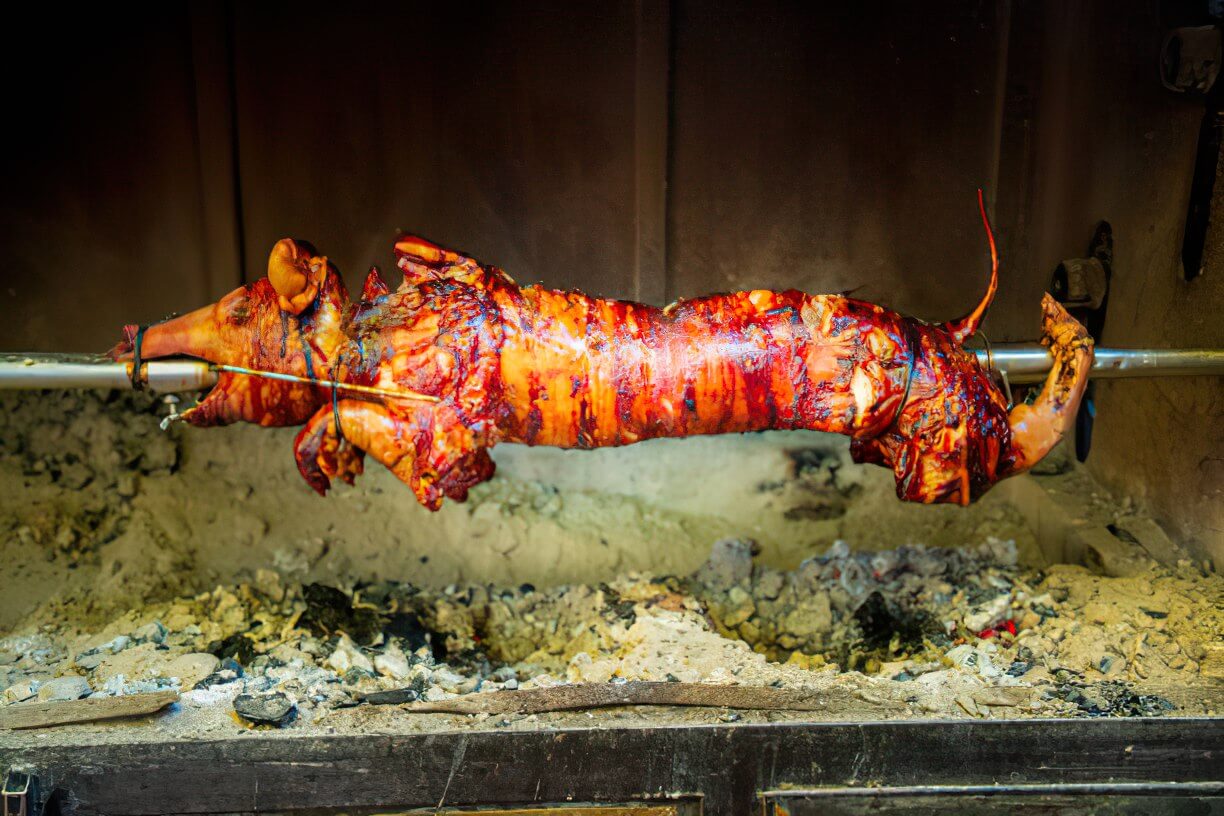It might be that time of the year where in you and your friends are planning to get together and have a grand celebration that involves great fiesta vibes as well as awesome food. Rather than the normal barbecued burgers or grilled ribs and porkchops, wouldn’t it be nice to have something different? What about something mind-blowing and tickle your friends and guests’ fancy bones?
How about serving them a culinary spectacle that will surely make their mouths water and their eyes widen with excitement and awe? How about serving them a whole roasted pig?
If you are ready to have this culinary adventure of a lifetime and are just looking for answers on where to start, you have definitely come to the right place! There are useful and highly informative key points below that will answer all your questions on how to go about roasting a whole pig. These will help you get started as well as meticulously guide you towards getting that whole roasted hog to perfection!
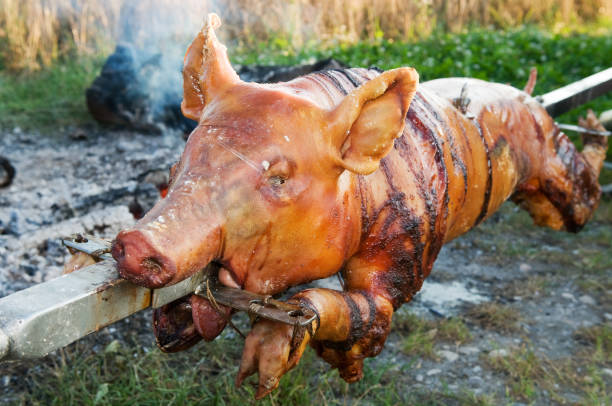
General Tips on How to Cook a Whole Pig
Want some tips on how to cook a whole pig for a whole pig roast? As I’ve mentioned, this endeavor is best for someone a little adventurous and ready to do a lot of work. As you might imagine, cooking a whole large animal can be hard and demand a lot of time and effort. But the results handsomely pay back all that hard work. To be honest, there is no set of instructions that you can follow to get your pig roast perfectly right the first time. Because every pig is different, every fire pit is different and every recipe is different, how to cook a whole pig will be different and you will have to get a feeling for the whole process on your own. Each time you do it you will find new ways to improve your outcome and how to cook a whole pig more efficiently with a better outcome. However, there are some basic things you will need and general principles which will help get you started so that you will be prepared and don’t experience any catastrophes, like your whole hog falling off the hog rotisserie into your fire! So read on and take some notes, the fun is about to begin!
Tips on How to Cook a Whole Pig
- Finding a Whole Hog or Suckling Pig – Without a whole pig, you can’t have a pig roast! Sourcing a whole hog can be tricky in some areas. However, there are some tricks to finding a source in your local area and even some farms that ship anywhere in the US.
- Your Fire Pit Heat Source – If you are cooking a whole hog, obviously you need a heat source! I don’t know how to cook a whole pig without heat! But that’s a good thing because I love working with fire! For an outdoor fire pit pig roast you can use any fuel that is good for cooking, either hardwood firewood or charcoal.
Assuming you have an adequate rotisserie, various types of fire pits can be used. For example, pictured above is a temporary fire pit which was built out of landscaping bricks placed on a non-flammable ground area. If you build this on an area you don’t want to be stained by the charcoal you can lay down a large piece of sheet metal first to form the floor of your fire pit. The barbecue pit is then simply filled with fuel, charcoal in the case of the picture above, and you have your heat source! Other options are to dig out a shallow area in the ground to act as your fire pit. This can then be filled with firewood and a big fire built and burned down until you have a good core of embers to grill over. You can even cook your whole pig over a portable cast-iron or copper fire pit as long as it is big enough and your rotisserie is tall enough.
Remember that for a large roast like this you don’t want high direct heat which will burn the skin of the pig quickly. You want enough heat to cook, but low enough that the pig can cook on a rotisserie slowly over hours. Therefore, don’t cook over a large direct flame of an active fire unless your rotisserie is high enough to keep your food away from the flames. Hot embers or charcoal are better. They give off a lot of radiant heat but don’t tend to burn nearly as fast as an open flame.
Whatever your fuel, be sure to spread it out so that all parts of your pig roast will cook relatively evenly. To accomplish this, it helps to take a temperature, with a grill thermometer or meat thermometer, at the surface of the pig at several locations. The temperature should be even and you can move coals or embers around to adjust if needed. If there is a differential, I prefer my most intense heat to be on the butt/hindquarters (ham) and shoulder areas where there is thicker meat and will take the longest to cook. - Hog Rotisserie – It is key to remember when learning how to cook a whole pig that a large animal will take a very long time to cook, usually several hours for full sized hogs. During that process you want the meat to cook evenly and the skin to brown nicely and acquire a beautiful caramelized glaze. However, you don’t want the skin to burn to a charcoal crisp! The ideal way to accomplish this is a hog rotisserie which will slowly turn your pig roast over your heat source at an adequate distance to keep it from burning quickly. For smaller suckling pigs you may be able to get away with a standard fire pit rotisserie. However, for larger whole hogs you need a heavy duty rotisserie which can hold and turn a large weight.
- Trussing Needle and Twine – A good trussing job is essential to successfully learn how to cook a whole pig. Without the trussing job, the roast will fall right off the rotisserie spit! It pays to go extra heavy on the trussing because while a raw pig may seem secure, as it cooks and the tissues become softer and even fall off the bone, the roast can shift and slip. Prevent this by doing an adequate trussing job from the get go! The trussing will consist of several loops of heavy-duty twine going through the back of the pig on either side of the spit and spine, securing the spine to the spit below. This should be done at about six inch intervals all the way down the length of the meat. The legs and head should also be wrapped and secured tightly so they are as close to and as tight against the spit as possible. Finally, the body cavity is sewn shut, after seasoning and filling with any stuffing you want of course.
- Meat Injector – As I’ll discuss elsewhere, pork, especially from a large hog, can lack some flavor and juiciness in the depths of the meat. One tip on how to cook a whole pig that is delicious is to infuse your roast with more flavor by marinating and/or brining the pig before cooking. However, because of the size of these roasts, much of the marinade or brine may not reach the depths of the meat. A large, heavy-duty meat injector (basically a large syringe with a large needle) can be used to inject marinade or brine deep into the meat.
- Whole Pig Recipes – When you learn how to cook a whole pig you’ll find that there are hundreds of different ways to prepare them. From basic BBQ roasts to ethnic preparations, from marinating to brining. All of them are good for different reasons. Search around for one which seems best for your taste. I have a couple examples on my Recipe Ideas for a Full Size Whole Pig and my Recipe Ideas for Roast Suckling Pig below. One of the general principles I recommend following is that for larger pigs, brining or marinating adequately is a must to instill as much flavor to the meat as possible. I personally like brining a larger pig at least overnight, if not longer, to really get all my flavors and juiciness deep into the meat. Suckling pig tends to be a bit more tender and flavorful on its own, but it definitely benefits from adequate seasoning or even brining as well.
- Baste, Baste, Baste! – While cooking your whole hog, remember that one of the best parts of the finished product is that beautiful caramelized glaze that develops on the crispy skin. It is both beautiful to behold when served as well as very tasty! When you learn how to cook a whole pig, you’ll find that basting your roast frequently will help to develop that glaze and add flavor to the skin. It will also help keep your pig roast moist, preventing it from drying out.
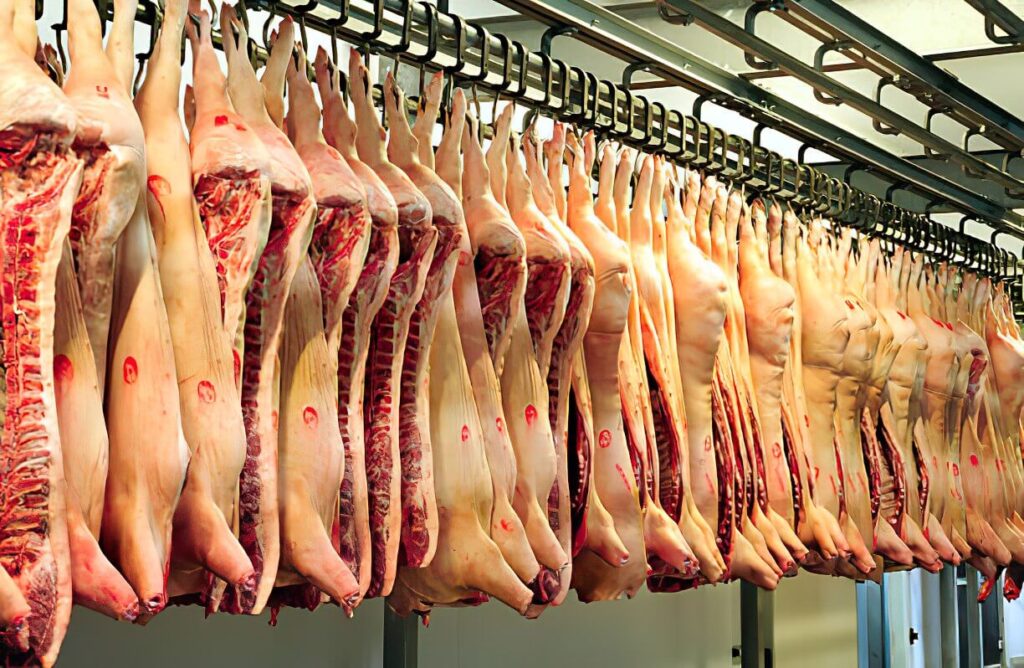
Where to Find Whole Hogs for Cooking
A whole hog roast is a festive occasion and quite an adventure! Fun for all those involved and resulting in delicious food, I definitely recommend trying it if you have the time and energy to pull it together. One of the two hardest things to overcome, the other being building or buying a hog rotisserie adequate to hold your hog, is sourcing a whole pig or suckling pig (assuming, of course, that you are not a hog farmer yourself!). In some areas, this may not be that hard, but in many areas, particularly in urban areas of the United States or Canada, this can be tricky. Most butchers do not sell whole hogs or suckling pigs. But with a little effort, you can usually track one down. So where do you find them? Read on!
Some tips for finding a whole hog, wherever you are:
- In rural areas, find a local pig farmer – This is probably the simplest and most direct way of tracking down a whole pig. Contact your local farmer and let them know what you are looking for. In most instances they will be able to fill your request. Suckling pigs may be harder to come by, depending on the time of year. Obviously, for those of us who live in or near cities, finding a local pig farm may not be an option, so read on.
- Talk to your favorite local butcher – Even if a butcher doesn’t carry whole hogs, many full-service butchers can special order them for you. Talk to your favorite butcher and see what they can do for you. If they can’t get it, they can often recommend another source for you. From experience, don’t bother at large chain supermarket butchers, like Whole Foods and others, as most of these simply receive pre-cut meats from their distributer and therefore are even that much further removed from the source. Focus on the dedicated meat markets or butchers in your area.
- Visit ethnic markets and butchers – Many ethnic cuisines use cuts of meats that we don’t see as frequently in basic American markets. This includes using whole animals like suckling pigs and whole hogs. I have had luck with both Mexican and other Latin American meat markets (try the markets in the same neighborhoods where they sell live chickens) and Asian markets such as 99 Ranch, Nijiya and other Chinese or Korean markets. Again, even if they do not have them in stock normally, ask the butcher if they can be special ordered for you. If not, they can often recommend another butcher in their area who can help you. In my experience, this is one of the less expensive sources for a whole pig.
- Online pig farmers – The miracle of the internet extends to more than downloadable music, email and news. As you probably know, just about everything you could want, you can find online. I have come across one excellent source online for whole pigs called McReynolds Farms which is outstanding. They supply several sizes of whole pigs, from small suckling pigs (as small as 10 lbs) to larger hogs (up to about 85 lbs). They also supply whole lambs and goats as well as several other accessories and supplies for cooking whole roasts such as larger rotisseries.
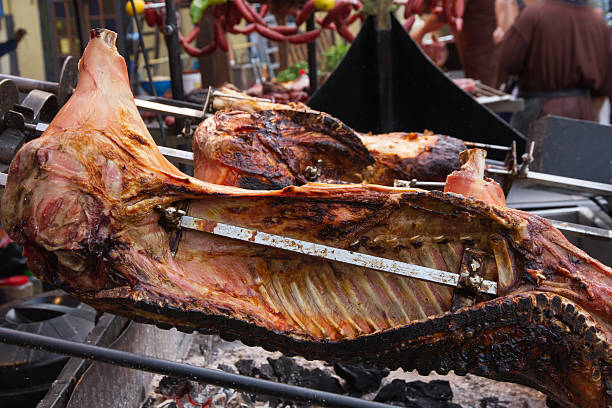
Buying, Building, and Using a Whole Hog Rotisserie
Cooking pig on a hog rotisserie is a wondrous event. The sights and smells and grander of it all are fantastic. To do so you need a pig rotisserie which will hold and turn the weight of your large investment, that beautiful whole hog you have prepared and are going to roast slowly over coals or firewood. What type of rotisserie you use depends much on what type of whole pig you plan to cook. From a 10 lb. suckling pig to a 200 lb. beast, you need to make sure you have the right equipment for the job. Here are some of the different options which can be used.
- Large Whole Hog Rotisserie – One of the easiest and most functional ways to roast a whole pig is on a heavy-duty pit rotisserie which was made specifically for that purpose. The rotisserie pictured above, called the SpitJack P150 Whole Hog Rotisserie or “The Beast”, is specifically designed to hold large whole roasts such as pigs, lambs or goats. It is field tested up to 200 lb.! That means that just about any large animal can be safely and securely roasted on this heavy duty device which slowly turns your roast for you over your fire pit. This whole pig rotisserie is only available from SpitJack.com. They also produce an 85 lb. model and sell several other fire pit and rotisserie supplies and accessories.
Whole hog rotisseries such as these are ideal because they are built to withstand high temperatures and significant weight. These are also nice because they are adaptable, allowing you to use the spit rotisserie over any type of fire pit with any type of fuel, charcoal or firewood. If you plan on cooking pig roasts regularly and want the best money can buy then these are a must!

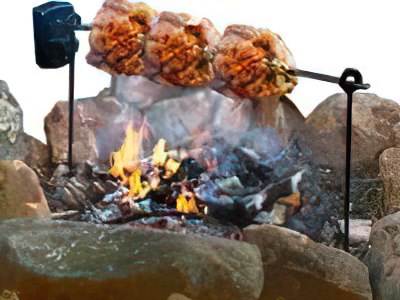
- Smaller Fire Pit Rotisseries for Suckling Pigs – For smaller roasts such as a true suckling pig (typically under 20 lb.) a smaller fire pit rotisserie can sometimes serve well. For example, these smaller rotisseries seen here, the Sojoe Rotisserie for the Sojoe Fire Pit and the Grizzly Spit Portable Rotisserie, both sold by SpitJack.com, both hold around 20 to 25 lb. comfortably. While they are not strong enough or large enough to roast a whole hog, these can be used for small suckling pigs beautifully. They set up over your existing portable or in-ground fire pit or campfire pit and the motorized spit perfectly roasts your smaller roasts. These are also ideal for other smaller roasts such as whole birds or leg of lamb.
- Homemade Rotisserie – While certainly the cheapest option for a hog rotisserie, there are several things to keep in mind when considering building your own pig rotisserie. Unless you are a very adept handyman (or handywoman) it may be hard to build your own rotisserie for a large whole pig roast. A full size, adult hog can weigh over 100 lb. You need to make sure that a homemade device can hold this type of weight safely. While a suckling pig only weights 10 to 20 lb. or so, if you plan to build a rotisserie for a larger pig you will need to make it sturdy. The ideal solution is an actual welded metal frame which can be moved over your fire pit. If you or someone you know is handy with metal-working then this may be a realistic option.
However, I have seen hog rotisseries crafted from some other pre-made items. Basically, what you need is a spit, which will hold the whole pig and which can be turned, and a frame or two side-posts which will hold the spit in place over your heat source. For example, one person I know built a rotisserie out of two old barbell holders which acted as the posts to support the rotisserie. They crafted a spit from a long piece of metal and attached it to an old washing machine motor to turn it. This contraption was not pretty but it worked perfectly and allowed them to roast great whole pigs and lambs.
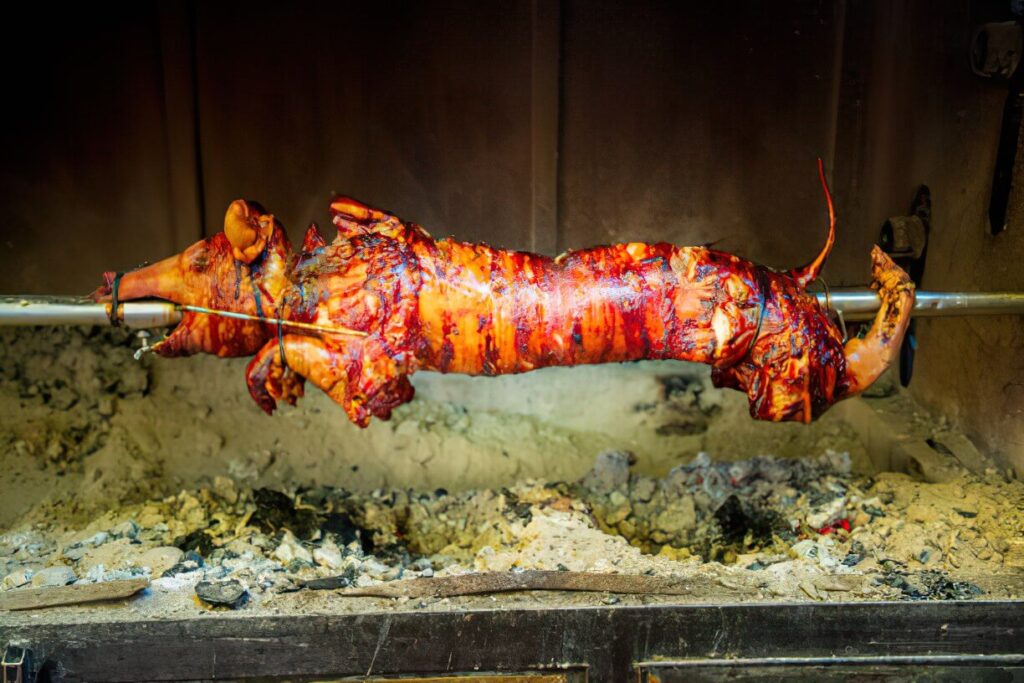
Cooking a Full-Size Whole Pig
A whole pig roast is a wondrous event, but if you’ve read How to Cook a Whole Pig then you know there is a lot that goes into it. A whole hog can be quite large and therefore requires special equipment and skills to pull off.
Some things to consider and plan for when cooking a whole pig roast:
Invite a Lot of Friends!
This may seem obvious, but most people do not realize just how much meat is on a large hog! Don’t plan a hog roast without sufficient friends and family to help you devour the tasty goodness when it is done. You’d hate to see all your hard work go to waste, wouldn’t you!
The Hog Rotisserie
- A suckling pig is typically under 25 lb. Therefore, whole hogs are generally significantly larger than that. While many that you’ll see roasted are 30 to 60 lb., larger adult hogs can easily weight from 100 to 200 lb. For this reason, you need a very heavy-duty and sturdy rotisserie, as seen above, to slowly and safely turn your pig roast over your fire.
- Why do you need a rotisserie in the first place? Why not just support the pig over your fire pit on a rack? A whole pig is a large roast! If left in one position over a fire or charcoal, one side would be burnt and crispy while the other side would be raw. Just like any cut of meat, you need to turn it to be fully cooked throughout. However, turning a whole hog is not as easy as flippin’ a burger! Just imagine trying to flip the hog, several times, while it is inches over hot embers. Think you could handle it? Well you’re wrong, this is a set-up for disaster. Turning a large whole pig roast over a fire by hand is next to impossible and you will end up with charred arms and eyebrows. A sturdy hog rotisserie is the only solution and in my opinion is critical to a successful pig roast.
- Many companies make whole hog rotisseries. Whatever you use, make sure it is weight tested for more than your pig weights so you know it will hold, and turn, that weight. The rotisseries featured here are designed and sold by SpitJack a great source for outdoor and fireplace cooking equipment. Their rotisseries are well designed and work perfectly.
Buying a Whole Pig
- Plan ahead for your pig roast! In most areas a whole fresh hog is not that easy to come by. Find a source for a whole hog well before you plan your party.
- Talk to your butcher. Most can special order whole pigs. Ethnic markets and butchers, Latin and Asian particularly, are a good place to start.
- When buying a whole pig, find out if it will come frozen or fresh. If frozen, be sure to leave sufficient time once you get it to defrost. An average sized hog will take at least 48 hours to defrost completely. If you are planning to marinate or brine it as well, this will take additional time before the whole pig roast so plan ahead and make sure you don’t run out of time!
- Also ask your butcher how the pig will come. Most are prepped for cooking, meaning their hair and internal organs have been removed. If they haven’t been prepped, make sure you have someone who can clean and prep the hog for you before cooking.
Prepping Your Whole Pig Roast: Marinating, Brining and Injecting
- A whole pig needs to be flavored. If you just throw it on your rotisserie and cook it, the large cuts of meat will be rather bland. But do not fret, pork takes to marinating and brining like a fish to water!
- There are many types of recipes for prepping a whole pig roast, but I particularly like brining. Brining uses a salt water solution to tenderize the meat and also to help the muscle fibers retain moisture. This helps infuse flavor and keep your roast succulent and moist. It will not dry out and become tough.
- There are many options for brine or marinade mixtures. One brine that I particularly love and works beautifully with pork is an apple cider brine described on my pork tenderloin barbecue recipe. The apple flavor and subtle sweetness really enhance and compliment the natural flavor of the meat. To add even more flavor, I like to add an abundance of herbs, onions, lemons, oranges and/or hot peppers to the brine solution.
- A whole pig should be brined or marinated for at least 24 hours overnight, if not longer. Additionally, injecting the thickest parts of meat with the marinade or brine solution will help to be sure your brine penetrates all of the meat, not just the surface cuts.
Prepping Your Whole Pig Roast: Trussing
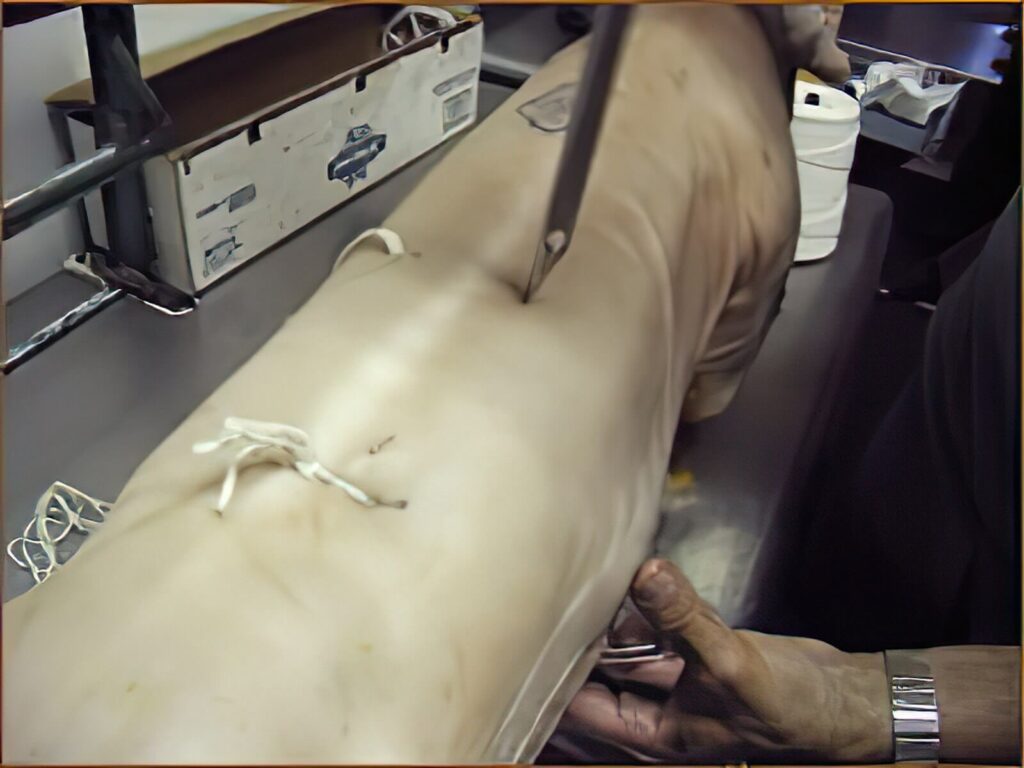
- Proper trussing of your whole pig roast to the rotisserie spit is critical. As your pig cooks it will loosen, move and shift. The muscle fibers will pull apart and away from the bone. The result? Your whole hog could fall off your spit! That would be disaster. Prevent this by trussing aggressively and tightly.
- In general, the spit should go between the thighs, along the inside of the body just under the spine and out through the mouth. Because the spit is not really going through meat, this is not secured to the spit. A large trussing need and heavy-duty kitchen twine should be used to secure the spine to the spit every 6 inches along the length of the meat. This should be tied as tightly as possible with the knots on the back. Cut off excess twine so that it will not burn.
- The hips, thighs and legs should also be trussed securely to hold them tight against each other and the spit. Same goes for the head and shoulders. You don’t want any wiggle or give in your pig, it should move as one with the spit.
- A great demonstration of how to truss a whole hog to a spit with pictures is available at SpitJack.
Go Slow and Easy
- A whole pig roast takes a long time, you cannot, and should not, rush it. Quickly grilled pork leads to burnt skin and dried out meat. Cook slowly over the fire pit on the rotisserie at lower temperatures (around 250 degrees or so at the surface of your roast is ideal).
- Whole hogs can take from 4 to 24 hours to cook completely depending on their size and the cooking temperature. So plan ahead and take your time.
- When you think the roast is nearing doneness, test the doneness with a meat thermometer. All internal temperatures of the deepest meat (the hams and shoulders will be the last to cook thoroughly) should be at least 160 degrees and ideally about 165.
Basting, Basting, and Then More Basting
- Basting with a good basting mixture helps to develop a nice thick, dark caramelized glaze on the surface of the roast. It also helps prevent the skin and superficial meat from drying out.
- Baste frequently throughout the cooking period, particularly when you notice the surface getting dry.
- Basting mixtures vary and can use any number of flavoring ingredients. Some examples of things to include are olive oil, wine, fruit juices, herbs and lemon juice. Even a little honey or sugar can enhance the flavor and help the caramelization. Just be careful not to put too much sugar on the surface of your whole pig roast or it will burn if it gets too hot. Remember, you want caramelization, not charcoal!
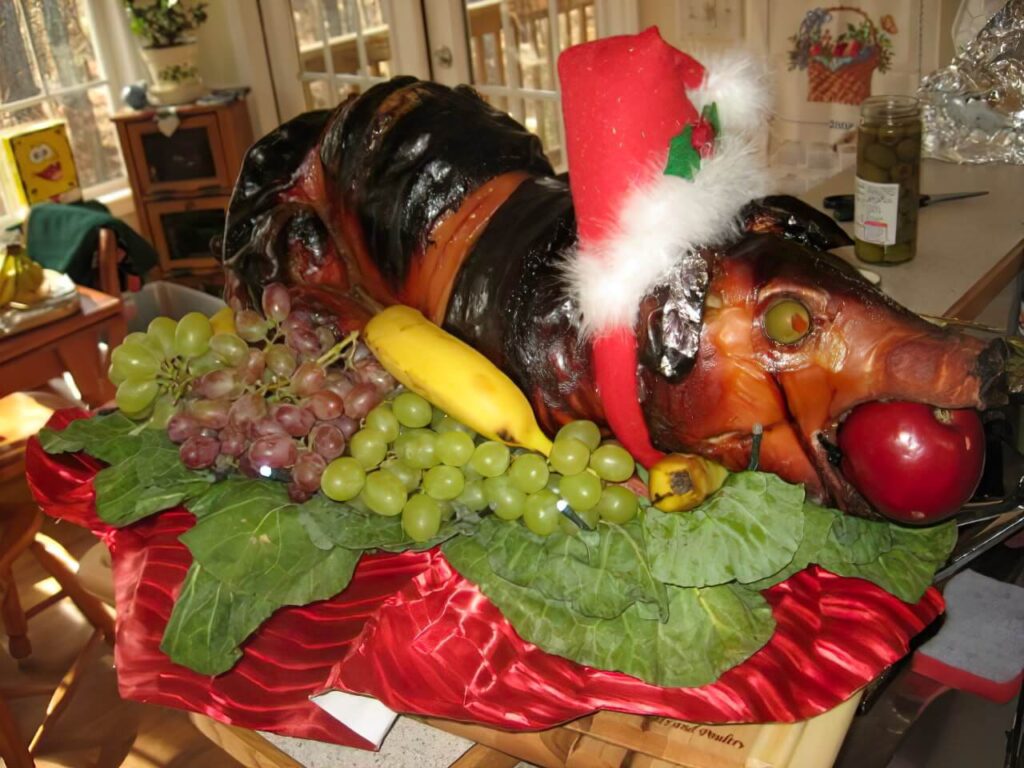
Whole Pig Roast Recipe
This whole pig recipe comes from one of my readers, Steve from Atlanta, GA! He submitted all these photos and info about how he cooked a Christmas Pig after getting some tips from this website. This isn’t quite a suckling pig as it was about 30 pounds but it’s not an adult whole hog either. I guess you’d call it a juvenile hog. He cooked it on his Weber grill rotisserie and had to truss it up and counterweight it, especially so that it would fit.
Here are his notes on how he did it. I think he makes some good points and it looks like it turned out beautifully!
Thanks, Steve!
Steve’s Whole Pig Recipe:
I found your site when searching for tips on cooking a whole hog. The whole pig went well! Folks were very happy and impressed. Most of all they were well fed. Thank you for your informative site.
I cooked a 29Lb pig on my (24″ wide) Weber Grill/Rotisserie. It took my equipment to the limit. My doctor spoke about bringing during Thanksgiving time and I was interested. He quickly pointed out the challenge of submersing a 29Lb pig into liquid in terms of quantity of liquid and size of the container.
I came up with an idea: I placed the whole pig in a heavy-duty contractor-grade 6ml plastic trash bag. I added salt, 1/2 gal of apple juice, 1/4 gallon of pineapple juice, and pineapple chunks into the bag with the pig. While leaving the bag unsealed, I placed it into a cooler filled with ice water. The ice water pressed the bag up against the pig and minimized the amount of required brine. I placed the cooler on wheels so I could roll it outside to drain.
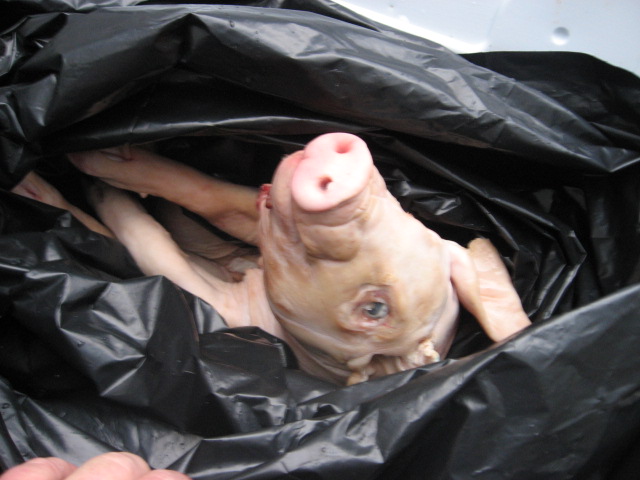
This is the 30 Lb. hog, in a plastic bag, floating in the brine. (The bag was placed in a cooler filled with water & ice).
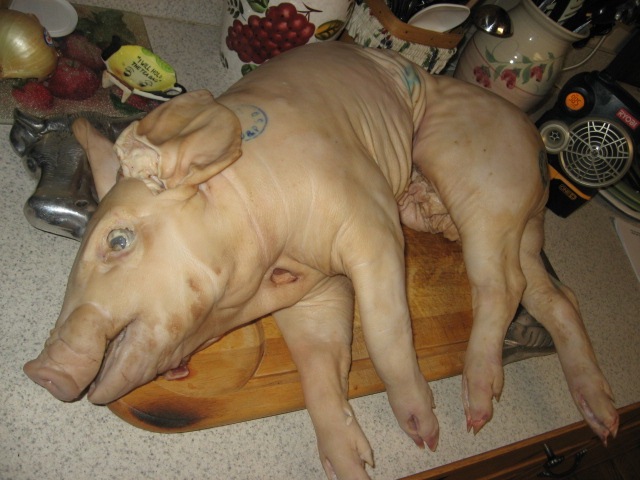
This is the hog just after removal from brine and before he was skewered.
The pig roast went well (again thanks to your info). I had to hunch his back up a little which shifted the center of balance. I had to add several 12oz lead fishing weights as a counterbalance and cooked him the night before the party.
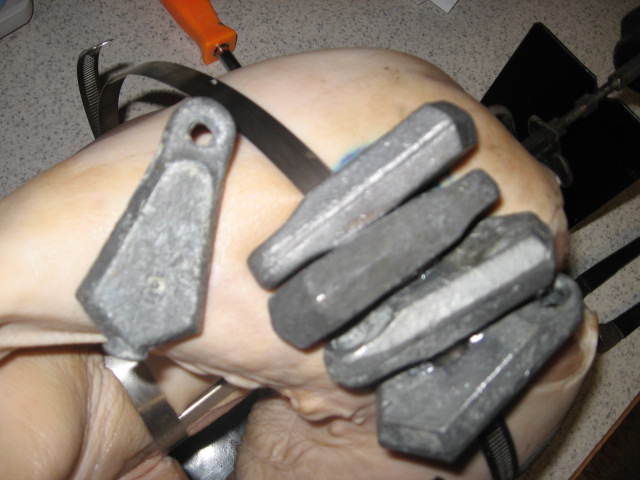
The hog required a counterweight. I used 12oz sinkers.
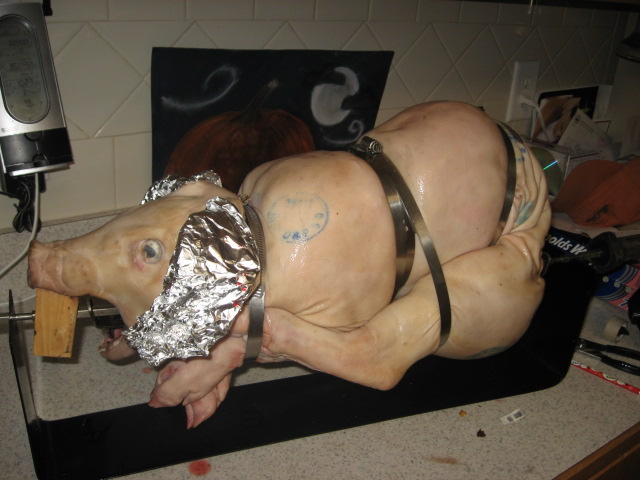
This is the hog just before he went onto the rotisserie. (Ears covered with foil to prevent burn-off) The Stainless Steel hose clamps are available at my local hardware store for about $2.50 each. They are much more reliable and faster than butchers twine. I used a cordless screwdriver to unclamp the hog-very fast method.
I'm using a standard Weber Grill and Weber Rotisserie. I had to prop the lid open and remove the "flavor bars" (Stainless Steel angles that burn off drip before it gets into the burners) to allow enough room for the hog to turn.
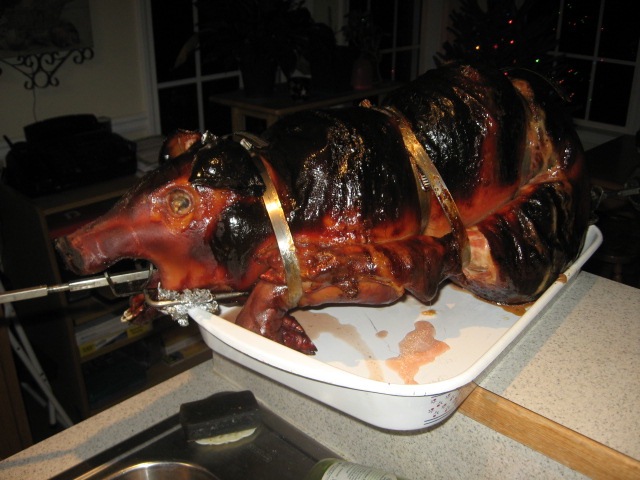
This is the hog when he came off of the heat. I cooked the hog until it reached 150-160 degrees F. (When I arrive at the party the following day, I planned to cut the meat off, place it in a foil pan [placing the skin and foil over top of the meat] and heat/finish cooking it prior to serving).
The next morning set the whole pig on collard greens, over red foil, into a tin pan, and over a large cutting board. I decorated with grapes and used green olives (with red pimentos) for the eyes. I weaved a small string of battery-powered blinking led lights into the collards for a festive look. On his head, he wore a Santa hat and had a red apple in his mouth. The apple kept falling out so I used an electrical wire tie to secure the apple.
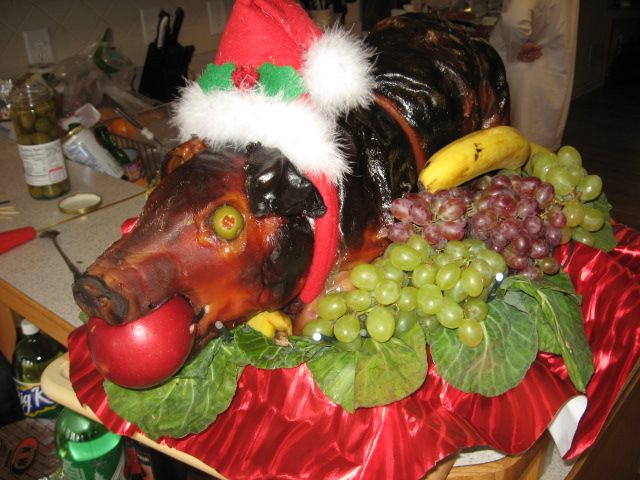
These were the hog prior to wrapping it up for transport to the party. I used olive for the eyes and had to tie the apple in using a plastic wire tie.
Once the presentation was ready, I laid two 1/2 gallon milk cartons on their side and placed everything on top. I then wrapped Saran Wrap around everything to make sure nothing moved during the ride to the party.
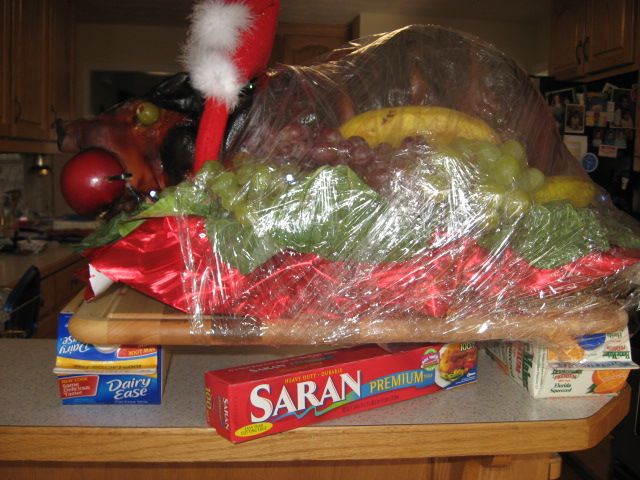
I used two milk cartons to suspend the hog for plastic wrapping. The wrap held all of these things together: The hog, collards, grapes, red foil wrapping paper, foil pan (that had a Ziplock bag concealed in it containing four pairs of surgical gloves for future meat cutting), and a large cutting board.
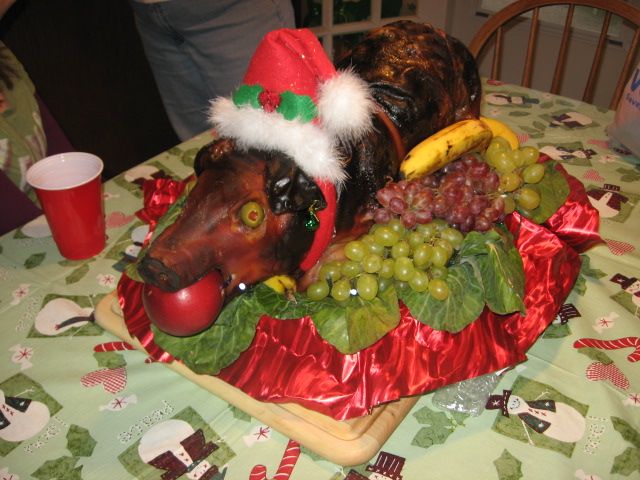
This was how the hog looked at the party after transportation. Note the Saran Wrap tucked under the red foil and the green Christmas ball ear rings.
Once everyone got their pictures & it was time to eat. I got a volunteer to help me pull the meat off, slice it up, lay it in the foil pan and cover it with the skin and some foil. We heated it in the oven at 350 degrees F for 45-minutes. The meat was served with four ‘over-the-counter’ flavors of the bar-b-queue sauce, rolls, and sliced tomatoes.
The group of 16 people ate this entire 30 Lb. hog!
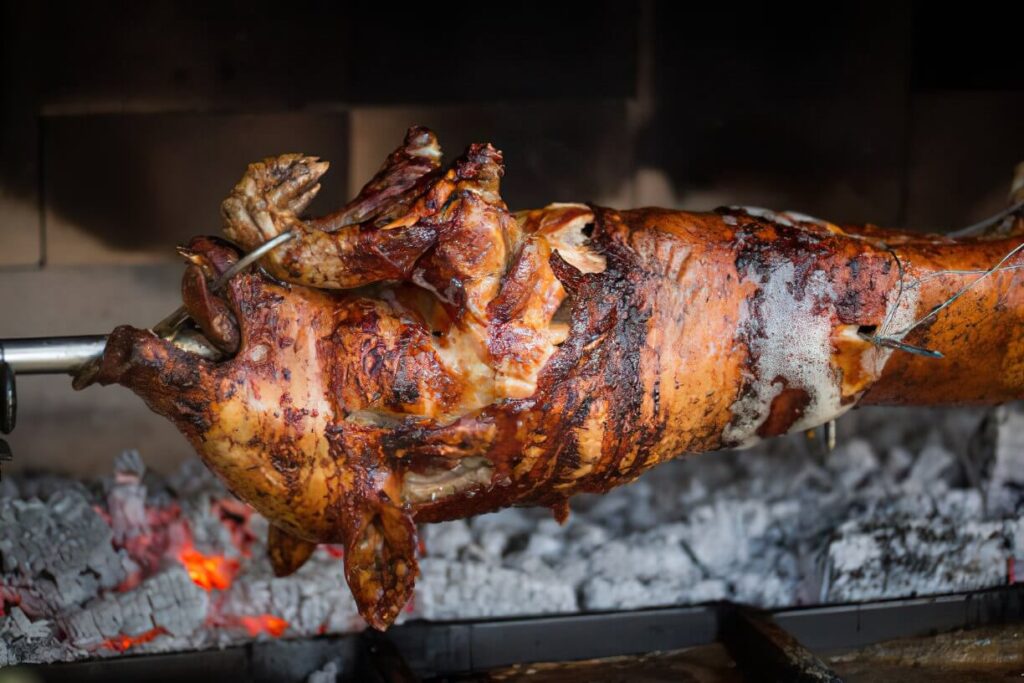
Cooking a Suckling Pig
A roast suckling pig is an almost holy thing in many cultures. To bring out a well glazed, perfectly done whole pig roast on a platter is the ultimate in presentation and festivity. It is the centerpiece of many celebrations and feasts. Young pigs also happen to be incredibly tender and succulent and downright delicious! While the smallest whole pigs can certainly fit in a large oven and can be prepared there, these delicious roasts lend themselves to cooking on an outdoor fire pit rotisserie very well. If you don’t have room for, or enough people to eat, an adult whole hog then a small young one is a great substitute. In fact, it is arguably better because of the more flavorful and tender meat.
While cooking a young pig in many ways is similar to cooking an adult whole hog, there are some subtle differences that are important to note.
Tips for Cooking a Whole Roast Suckling Pig:
How and Where to Buy a Whole Piglet
- Finding a whole pig can be tricky in some areas.
- Obviously, if you have a connection with a local pig farmer, this may be the easiest and most direct way to find a suckling pig.
- You can also special order them from good butchers, particularly ethnic butchers in Latino, Asian or Greek markets.
- Finding suckling pigs are a bit different from larger hogs. The young pigs may only be available during some times of the year, spring and summer most commonly. Additionally, because young pigs are so small, the typical price per pound would not be profitable to the farmers to raise just to sell as small pigs. For this reason, some farmers and distributers don’t even sell suckling pigs. For others, the prices may be quite high for this rare commodity.
- Shop around and ask around to find the best availability and prices.
- Keep in mind that the term suckling pig means different things to different people. A true suckling pig, which is still nursing and their primary diet is milk, should be from around 9 to 20 lb. or so. However, you may find butchers who will call a pig that is quite bigger a suckling pig. So be sure to indicate the exact size you are looking for and shop around to find a source who can get you exactly what you need.
Cooking Technique: Barbecue Pit Rotisserie versus Grill or Barbecue
- Because a roast suckling pig is quite a bit smaller than other whole hogs some people may consider cooking them on a grill or barbecue. I do not feel this is a good way to cook a whole piglet for a few reasons. To cook a whole pig perfectly, you need a relatively low, indirect heat to slowly cook the roast completely without burning the skin. High direct heat on a grill can quickly burn the skin and will lead to uneven cooking. Most grills, except maybe for very large gas grills, are not big enough to accommodate a whole pig when set up for indirect heat grilling. Additionally, even with a large grill set up for indirect heat, the roast would need to be turned frequently throughout the cooking process to cook evenly and completely. Flipping a hot, glazed whole animal is quite a bit harder than you may think. Save your arm hair and avoid using a grill or barbecue to cook a whole suckling pig.
- Rather than a grill or barbecue, a hog rotisserie set over a fire pit with charcoal or firewood as fuel is the ideal means to roast a whole pig. While it may take a bit more effort and/or money to build or purchase an adequate rotisserie to hold your whole roast, the payback will be unlimited. Your roasts will be much more evenly cooked, juicy and tender. Such a rotisserie can also be used for many other things including whole lamb roasts, goat, large whole poultry and any other large roasts you care to grill up. They are a very useful and make a large whole roast so much easier and more successful. The fire pit you use can be anything, including a dug-out hole in the ground, a free-standing portable fire pit, a temporary fire pit built of bricks, or even a permanent stone or brick fire pit. Basically any pit you can set your rotisserie over will do!
Recipes and Preparation: To Brine or Not to Brine
- While I will post some recipe ideas for roast suckling pig elsewhere, there are a few things to consider in planning on how to cook a whole pig.
- For one, while brining or excessive marinating and the use of meat injectors is critical for larger whole hogs, young suckling pigs have such succulent and tender flesh that they do not need as aggressive flavoring methods. However, I feel that these still do help for most recipes. The more flavor the better, right? I would strongly consider brining your suckling pig with a brine solution and assortment of herbs, spices and/or fruits to really crank up the flavors to a higher level. At the very least I recommend rubbing all the surfaces and inside of your suckling pig with abundant coarse salt the day before cooking. Before cooking, this should be brushed off. This acts similar to brining and helps keep the meat tender, juicy and richly flavored.
- The remainder of preparation and cooking of a suckling pig is otherwise very similar to other large roasts. Just like a larger pig they should be trussed very securely to your rotisserie. They should also be basted frequently throughout the cooking process to keep the surface moist and to develop a beautiful, rich glaze on the skin. This will bring great flavor and beauty to your finished roast!
Roast Suckling Pig Recipe Ideas
Roast suckling pig is delicious! It is also fun and a spectacle for all. There are many different ways to roast a whole pig, far too many to mention all here. Each culture seems to have its favorites, from Greek stuffed pig to Cuban-style roast pork, to Chinese glazed suckling pig, to Southern French stuffed suckling pig. Here I will discuss a couple of general ideas about the cooking process and give an example of a couple of recipe ideas, a fig-stuffed Southern French pig and a brined suckling pig.
Trussing
Trussing a whole pig is a very important and often overlooked part of cooking a whole pig roast on a hog rotisserie. While a roast suckling pig is not nearly as heavy as a large whole hog, they also need adequate trussing with heavy-duty kitchen twine. This helps to keep the whole animal tightly against the rotisserie spit and as it cooks prevents it from loosening and falling off. I suggest trussing a roast suckling pig just like you would a large pig, with several loops around the spit and spine as well as trussing the legs tightly against the body and the spit.
Brined Roast Suckling Pig
This is one of my favorite brine solutions for pork. I also use it to brine other cuts such as brined pork tenderloin. It does have a fairly intense sweet apple flavor so if you prefer a more mellow flavor for your roast you can use less apple cider, salt, and/or sugar. However, the high salt solution really helps to intensify the flavors of the meat and to help keep the meat tender and juicy. Also, I particularly like the apple flavor with pork (even better if you use some applewood to smoke the roast!) but you can certainly use other fruit flavors. One excellent option is a citrus-based brine with lemons, oranges, and orange juice for the brine and basting liquid. Experiment and see what you like!
What you will need:
- For the Brine (make as many batches of this as needed to completely cover your suckling pig):
- 8 cups apple cider
- 7 cups water
- 1 cup coarse sea salt
- 1 cup packed brown sugar
- 6 tbsp coarsely ground black pepper
- 4 tsp dried rubbed sage
- 2 tsp ground cinnamon
- Large onion, cut up
- Apples pieces
- Dash of ground cayenne pepper
- A suckling pig (about 10 to 12 lb.)
- Olive oil
- Optional: additional pork fat from the butcher
- Several additional apples, onions and sage leaves, chopped coarsely
- Salt and pepper
- Additional apple cider for basting
- A bottle of rosé or rich white wine, more if needed
How to Prepare It:
- One or two days before cooking, prepare the brine solution. Stir thoroughly to make sure all the salt and sugar are completely dissolved. Make enough to completely cover your suckling pig in a large pot or other container. For very large roasts you can find very large boiling pots or whole turkey fryers at kitchen supply shops. For even bigger roasts, you can use a new, cleaned plastic trash can.
- Reserve the brining pig in a cool place for about 24 hours or more.
- On the day of cooking, remove the pig from the brine and pat dry with towels.
- Make several superficial slits in the skin, not through the skin completely to prevent the skin from rupturing as it cooks. Make one long slit down the back and several diagonal slits on each side. None of the slits should touch any other.
- Rub the pig with olive oil on all its surfaces.
- Truss the suckling pig to your rotisserie spit.
- Fill the body cavities with coarsely chopped apples, onions and sage leaves seasoned with salt and pepper. Close the body cavity securely with twine.
- If cooking in an oven, the pig’s own fat will collect in the roasting pan and, combined with the wine and apple cider, makes a good basting liquid. However, when roasting over an open fire or charcoal the fat falls into the fire and cannot easily be collected. Instead, if you are able to get extra pork fat from your butcher, this can be rendered in a pan and then combined with warm wine and cider to create a suitable basting mixture. If no fat is available, olive oil and/or melted butter mixed with the warmed-up wine and cider can substitute. Keep this mixture warm, near boiling.
- Check that the temperature at the level that the roast suckling pig will be is around 250 to 350 degrees above your fire pit. A meat thermometer or grill thermometer is good for doing this. If it is much hotter than this, let your heat source burn down a while until the heat is lower. This heat can then be maintained by occasionally adding small amounts of firewood or charcoal. At lower heat (250 – 300 degrees) your roast suckling pig will cook slower, but will end up more tender and evenly cooked). At higher temps it will cook faster but not as well.
- Place the spit on your rotisserie over the fire pit and begin cooking.
- After about 30 minutes or so, begin basting liberally with the pork fat and wine mixture. Baste every 10 to 20 minutes. Over time this will help develop a rich, glazed appearance to the skin.
- Continue cooking in this manner, basting regularly and occasionally tending the fire to maintain even and constant heat, for about 3 to 3 and a half hours. This cooking time will depend on the heat of your fire pit as well as the size of your roast suckling pig. Therefore, this number can vary quite dramatically. If in question, you can check the internal temperature in the deepest parts of the meat and in the chest cavity with a meat thermometer. Pork should reach about 150 to 160 degrees at least to be finished.
- When done, remove your spit from your rotisserie and set the roast suckling pig aside to rest for about 30 minutes. Then place in a large platter and remove all the trussing twine and the spit.
Your roast suckling pig is now done and can be presented at the table and carved carefully. I recommend first removing the shoulder and hind legs at the joints. These pieces then can be sliced to serve. Next make a cut down the middle of the back, down the spine. Carefully cut from the shoulder cut, hugging the bone of the ribs and spine, down to where the hams (rump and hind-leg) were removed. This large piece will include the rack and loin cuts as well as the pork belly. It can be sliced crossways to serve. The meat between the ribs can also be freed and the stuffing can be scooped out. Enjoy!
Southern French Fig-Stuffed Roast Suckling Pig
This is a great recipe that can be made either on a rotisserie over a fire pit or in an oven if the pig is small enough.
What you will need:
- A suckling pig (about 10 to 12 lb.)
- A box of coarse salt
- Olive oil, about 3 or 4 tbsp plus extra for basting
- A bottle of rosé or rich white wine, more if needed
- 1 lb. chard leaves – thick stems removed, boiled for a few seconds, rinsed in cold water, drained and chopped.
- 12 oz old, firm bread, crust removed, soaked in milk and squeezed so that it is almost dry
- 4 oz young, fresh goat cheese (chevre)
- 4 oz ricotta cheese
- 2 eggs
- 12 oz fresh figs, chopped coarsely
- 4 oz walnuts, chopped
- 2 cloves, ground to a powder
- Freshly grated nutmeg, a pinch
- Additional salt and pepper
- Optional: Additional pork fat from the butcher
How to prepare it:
- The day before cooking, pour abundant coarse salt all over the pig, inside and out, and rub in to all surfaces. Place in a large tray and leave overnight in your refrigerator or other cool place.
- The next day, discard the liquid which has accumulated in the tray and wipe the suckling pig dry with towels.
- While your fire pit is being prepared, prepare the stuffing for the pig. Mash together the eggs and cheeses in a large bowl. Add the walnuts, figs, chard, milk-soaked bread pieces, cloves, nutmeg and salt and pepper and mix all the ingredients together thoroughly with your hands.
- After trussing the whole pig to the rotisserie spit securely (but not yet set over the fire pit!) and before lacing up the chest and abdominal cavity, push the stuffing into the pig’s chest cavity and then the abdominal cavity.
- Lace up the abdominal opening securely and truss the legs.
- With a sharp paring knife make superficial slits in the skin, never cutting all the way through the skin. One cut should go down the back and there should be three or four down each side diagonally from front to back. None of the score marks should cross another. The purpose of this is to prevent the skin from rupturing as the pig cooks and the skin tightens.
- Rub all over with olive oil and wrap pieces of aluminum foil around the ears and tail to prevent their burning. These can be removed a few minutes before the roast suckling pig is done.
- If cooking in an oven, the pig’s own fat will collect in the roasting pan and, combined with the wine, makes a good basting liquid. However, when roasting over an open fire or charcoal the fat falls into the fire and cannot easily be collected. Instead, if you are able to get extra pork fat from your butcher, this can be rendered in a pan and then combined with warm wine to create a suitable basting mixture. If no fat is available, olive oil and/or melted butter mixed with the warmed-up wine can substitute. Keep this mixture warm, near boiling.
- Check that the temperature at the level that the roast suckling pig will be is around 250 to 350 degrees above your fire pit. A meat thermometer or grill thermometer is good for doing this. If it is much hotter than this, let your heat source burn down a while until the heat is lower. This heat can then be maintained by occasionally adding small amounts of firewood or charcoal. At lower heat (250 – 300 degrees) your roast suckling pig will cook slower, but will end up more tender and evenly cooked). At higher temps it will cook faster but not as well.
- Secure your spit to the rotisserie and begin it turning.
- After about 30 minutes or so, begin basting liberally with the pork fat and wine mixture. Baste every 10 to 20 minutes. Over time this will help develop a rich, glazed appearance to the skin.
- Continue cooking in this manner, basting regularly and occasionally tending the fire to maintain even and constant heat, for about 3 to 3 and a half hours. This cooking time will depend on the heat of your fire pit as well as the size of your roast suckling pig. Therefore, this number can vary quite dramatically. If in question, you can check the internal temperature in the deepest parts of the meat and in the chest cavity with a meat thermometer. Pork should reach about 150 to 160 degrees at least to be finished.
- When done, remove your spit from your rotisserie and set the roast suckling pig aside to rest for about 30 minutes. Then place in a large platter and remove all the trussing twine and the spit.
Your roast suckling pig is now ready to be carved and served!
Don’t be scared if you are a little hesitant to get into roasting a whole pig right away. It is okay if you think that you want to start at something smaller and less daunting. That is why there is also information regarding roasting a whole lamb as well as other great roasting recipes that you can practice on just to get the ball rolling.
The information that is provided will certainly open up your mind to the many wonderful experiences of open-pit roasting and even the simple joys of grilling in itself. You might also start conversations and find people whom you can directly chat or talk about when it comes to cooking that entire pig. The possibilities of learning are endless.
Soon, it won’t be surprising that you will find yourself cooking a whole roasted pig in your fire pit and giving advice as well as tips to your friends who want to try out the unique recipe that you discovered. All it takes is one or two clicks and you’re off! There is no need to feel pressured at all! The important thing is to have fun trying out new, exciting culinary adventures!
Hi, I’m Adam and I’m a HUGE fan of Food and Cooking.
Do you enjoy grilling sessions with your family while staring at the beautiful fire pit flames?
Flame Gorilla is the site to learn how to have that perfect backyard experience.

